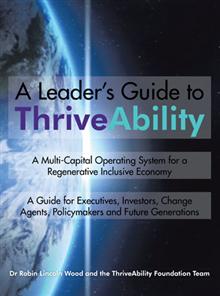This guest blog post was written by Robin Lincoln Wood. Dr Wood is a renowned strategist, futurist, communicator and agent of transformation. He has spent 3 decades working at board level with the worldâs leading organizations in 35 countries on 4 continents. He is deeply skilled in designing & catalyzing major shifts in large scale systems, & in inspiring & empowering the teams that deliver them. This post is an excerpt of a paper that will be published in the Integral Leadership Review in October 2015.
Earthâs 7.3 billion citizens are currently consuming 1.6 planetâs worth of resources, thereby guaranteeing runaway global warming, climate change and suffering for billions in the next few decades. Such a wicked problem needs a whole new kind of leadership, capable of thinking and acting on a planetary scale while maintaining local viability. New kinds of leadership are emerging in response, capable of working from perspectives that access the highest leverage points in human, social, natural and technical systems, while integrating multiple disciplines, methods and tools for beneficial change and transformation. This post is a primer for the book âA Leaderâs Guide to ThriveAbilityâ, details where we are (a degenerative, exclusive economy); where we need to be (a regenerative inclusive economy); the integral framework undergirding the ThriveAbility Journey, which explains how we get from here to there; and the role and kinds of leadership needed to assure a beneficial transition.
Toward a Regenerative, Inclusive Economy
Imagine a world powered by renewable energy, where all human beings thrive in resilient habitats; where businesses operate in a circular economy that regenerates natural capital, without a particle of waste, and are led by enlightened leaders whose goal is to maximize the ThriveAbility of all their stakeholders; where each individual is empowered to pursue their passion and make a living in service to others; where governance systems are transparent, effective and wise in the ways in which they deliver their services to their communities and populations; and where intercultural appreciation and insight enriches the exchanges between the diverse worldviews and cultures embraced by humankind.
Does that sound like an impossible dream, or pie in the sky? The co-creators of ThriveAbility would point out that every single one of these âpockets of the futureâ is currently observable in the present, right here and right now, somewhere in the world. It is just that the future is distributed unevenly, and sometimes hard to see when one is up to oneâs neck in alligators and trying to drain the swamp.
We can begin by describing in very big picture terms what a desirable future scenario of a thriving human civilization on a thriving planet might look like.
The Six Desiderata of ThriveAbility
Based on the pioneering work being done by hundreds of thought and practice leaders around the world[1], we have framed six desiderata by which we can measure the endpoint of the ThriveAbility Journey toward a regenerative, inclusive economy:
1. A Circular, regenerative economy
a. Natural and man-made materials and ecosystems are regenerated through circular economic processes
b. All impacts are managed proportionately to the carrying capacities of the multiple capitals
2. Long term resource planning for intergenerational equity
a.Technologies, Products, Services and Businesses designed for durability to continue serving future generations
b.Innovations are inspired by natural systems by engineers, designers, entrepreneurs and others working with the grain of nature.
â3. A Transparent and Level global playing field that delivers True Value
a.Apply true accounting principles that measure true costs including externalities, and calculate true returns with full transparency
b.Level the playing field towards renewable and regenerative industries through true taxation and incentives
â4. Strategic Decision-Making to Scale-Up to ThriveAble Sectors
a.Nurture multi-stakeholder collaboration to amplify and scale up positive impacts
b.Investment decisions based on the ThriveAbility Index
â5. Holistic Education to Develop Complex Systems Thinking & Leadership
a.New open business models for education that integrate physical wellbeing, mental depth, emotional maturity and spiritual development.
b.Developmental pathways based on co-working and co-creation between disciplines and sectors that are aspirational and compelling for future generations
6. Governance Systems Aligned to Inclusive Stakeholder Wellbeing
a.Radically inclusive and transparent governance structures that serve the different priorities and needs of different developmental levels
b.Innovative structures for and approaches to interworking between governments, NGOâs, businesses and academia that focus on Stakeholder ThriveAbility.
We believe that starting from this “end of the telescope”, what is required for regenerative, inclusive business becomes obvious fairly quickly to key decision makers and stakeholders. In this sense the ThriveAbility Approach and Index act as a powerful catalyst and producer of the aspirations and the cognitive dissonance required to make transformative changes a reality.
To put it bluntly, we have no choice whether we should move from a degenerative, exclusive economic system to a regenerative, inclusive one that can ensure the thriving of our biosphere and ourselves.
[1] In the course of researching and writing âA Leaderâs Guide to ThriveAbilityâ we met with and/or interviewed 83 global thought leaders, executives and investors shaping the future of business, sustainability and human flourishing during late 2014 and early 2015. Since then we have engaged with a further few hundred such leaders via ThriveAbility live gatherings, ThriveAbility Think Tanks hosted by Convetit, and videoconferencing.





